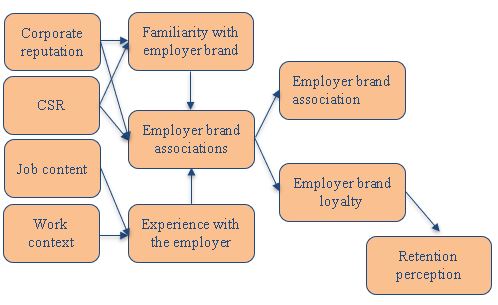Impact of Employee Value Proposition on Employee Retention:
A conceptual paper
Abstract
According to the Labour Demand Survey (2017), conducted by the department of census and statistics, in Sri Lanka, sewing machine operators are the number one employee category that reported the highest percentage of labour turnover. Therefore, the apparel sector organizations must have a mechanism to retain their talented employees. Employer branding has been a strategic reaction towards attracting prospective employees and retaining them within. Employer branding is plausible through ‘Employee Value Proposition’ (EVP)─a set of values that employees expect in return for their offer of service to a particular organization. Thus, this paper presents a conceptual framework in modeling the EVP and its related context using a targeted literature review on the basic concepts of employer branding, EVP, and other related areas. As a result, the conceptual framework that the researchers developed, provides a basis to conduct further empirical studies to identify relationships among EVP, employee brand equity, and employee's intention to retain with the moderating effect of some demographic factors. This result is appreciable as it paves the way to conduct empirical research aiming at finding solutions to resolve employee turnover issues in the apparel industry In Sri Lanka.
Downloads
References
Abbassi, S. M., & Hollman, K. W. (2000). Turnover: The Real Bottom Line. The journal of Public Personnel Management Volume, 29(3), 333-342. doi:10.1177/009102600002900303
Adler, H., & Ghiselli, R. (2015). The Importance of Compensation and Benefits on University Students' Perception of Organizations as Potential Employers. Journal of Management and Strategy, 6(1), 1-9. doi:10.5430/jms.v6n1p1
Alkandari, Q., & Hammad, A. A. (2009). Employees retention in private sector: an exploratory study in the state of Kuwait. Open Univercity,Malaysia. Retrieved from https://www.scribd.com/doc/55622649/Employees-Retention-in-Private-Sector-an-Exploratory-Study-in-the-State-of-Kuwait
Alshathry, S., Clarke, M., & Goodman, S. (2017). The role of employer brand equity in employee attraction and retention: a unified framework. International Journal of Organizational Analysis, 25(3), 413-431. doi:10.1108/IJOA-05-2016-1025
Amarathunge, B. B. (2016). Determinants of Intention to Leave among Operational Level Employees: A Study at a Leading Apparel Manufacturing Company in Sri Lanka. Department of Human Resource Management, University of Sri Jayewardenepura, 3(1). Retrieved October 8, 2016, from http://dr.lib.sjp.ac.lk/handle/123456789/3628
Ambler, T., & Barrow, S. (1996). The employer brand. The Journal of Brand Management, 4(3), 185-206. doi:10.1057/bm.1996.42
Armstrong, M. (2006). A Handbook of Employee Reward Management and Practice. London: Kogan Page Limited. Retrieved from https://hrproblog.files.wordpress.com/2012/05/a_handbook_of_employee_reward_management_and_practice.pdf
Ashforth, B. E., & Fred, M. A. (1989). Social Identity Theory and The Organization. Academy of Management Review, 14(1), 20-35. Retrieved from https://doi.org/10.5465/amr.1989.4278999
Aycan, Z., Kanungo, R. N., Mendonca, M., Yu, K., Deller, J., Stahl, G., & Kurshid, A. (2000). Impact of Culture on Human Resource Management Practices: A 10-Country Comparison. Applied Psychology-an International Review-psychologie Appliquee-revue Internationale- APPL PSYCHOL-INT REV, 49(1), 192-221.
Aycan, Z., Kanungo, R., Mendonca, M., Yu, K., Deller, J., Stahl, G., & Kurshid, A. (2000). Impact of Culture on Human Resource Management Practices: A 10-Country Comparison. Applied Psychology-an International Review-psychologie Appliquee-revue Internationale - APPL PSYCHOL-INT REV, 49, 192-221. doi:10.1111/1464-0597.00010
Backhaus, K., & Tikoo, S. (2004). Conceptualizing and researching employer branding. Career Development International, 9(5), 501-517. doi:10.1108/13620430410550754
Baruch, Y. (2004). Managing Careers: Theory and Practice. Prentice-Hall: Harlow. Retrieved from https://www.researchgate.net/publication/260036459_Managing_Careers_Theory_and_Practice/citation/download
Board, T. C. (2001). Engaging employees through your brand. Washington,DC: The Conference Board. Retrieved from https://conference-board.org/publications/publicationdetail.cfm?publicationid=461
Böckerman, P., & Ilmakunnas, P. (2005). Job Disamenities, Job Satisfaction and on-the-Job Search: Is There A Nexus? SSRN Electronic Journal. doi:10.2139/ssrn.642542
Brooks, M. E., Highhouse, S., Russell, S. S., & Mohr, D. C. (2003). Familiarity, ambivalence, and firm reputation: Is corporate fame a double edged sword? Journal of Applied Psychology, 88(5), 904-914. doi:10.1037/0021-9010.88.5.904
Cable, D., & Turban, D. (2001). Establishing the Dimensions, Sources and Value of Job Seekers’ Employer knowledge during recruitment. Research in Personnel and Human Resources Management, 20, 115–163. doi:10.1016/S0742-7301(01)20002-4
CIPD. (2013). Resourcing and talent planning. Chartered Institute of Personnel and Development. Retrieved from https://www.cipd.ae/Images/resourcing-and-talent-planning_2013_tcm22-11302.PDF
Collins, C. J., & Kanar, A. M. (2013). Employer brand equity and recruitment research. In D. M. Cable, & K. Y. Yu (Ed.), The Oxford Handbook of Recruitment (pp. 284–297). Oxford: Oxford University Press. doi:10.1093/oxfordhb/9780199756094.013.0016
Crewson, P. E. (1997). Public-service motivation: Building empirical evidence of incidence and effect. Journal of Public Administration Research and Theory, 7(4), 499-518. doi:10.1093/oxfordjournals.jpart.a024363
Cropanzano, R., & Mitchell, M. S. (2005). Social exchange theory: an interdisciplinary review. Journal of Management, 31(6), 874-900. doi:10.1177/0149206305279602
Das, B. L., & Baruah, M. (2013). Employee Retention: A Review of Literature. IOSR Journal of Business and Management, 14, 8-16. doi:10.9790/487X-1420816
Davies, G. (2008). Employer branding and its influence on managers. European Journal of Marketing, 42(5/6), 667-681. doi:10.1108/03090560810862570
Dheerasinghe, R. (2009). Garment Industry in Sri Lanka Challenges,Prospects and Strategies. Staff Studies, 33(1), 33-72. doi:10.4038/ss.v33i1.1246
EDB. (2017). ANNUAL REPORT. Sri Lanka Export Development Board . Retrieved from https://www.parliament.lk/uploads/documents/paperspresented/annual-report-srilanka-export-development-board-2017.pdf
EDB. (2017). Industry capability report. Export Development Board (EDB), Sri Lanka. Retrieved from https://www.srilankabusiness.com/publications/industry-capability-reports/page2.html
Edwards, M. (2010). An integrative review of employer branding and OB theory. Personnel Review, 39(1), 5-23. doi:10.1108/00483481011012809
Frow, P., & Payne, A. (2011). A Stakeholder Perspective of the Value Proposition Concept. European Journal of Marketing, 45, 223-240. doi:10.1108/03090561111095676
George, W. S. (2013). Principles of Human Resource Management. South Western: Cengage Learning. Retrieved from https://books.google.lk/books/about/Principles_of_Human_Resource_Management.html?id=sjYHfAEACAAJ&redir_esc=y
Haines, V. Y., Rousseau, V., & Brotheridge, C. M. (2011). A qualitative investigation of employee business awareness. Personnel Review, 41(1), 73-87. doi:http://dx.doi.org/10.1108/00483481211189956
Hendry, C., & Jenkins, R. (1997). Psychological contracts and new deals. Human Resource Management Journal, 7, 38-44. doi:http://dx.doi.org/10.1111/j.1748-8583.1997.tb00272.x
Jeffrey, P. (2007). Human Resources from an Organizational Behavior Perspective: Some Paradoxes Explained. Journal of Economic Perspectives, 21(4), 115-134. doi:http://dx.doi.org/10.1257/jep.21.4.115
Jiang, T. T., & Iles, P. A. (2011). Employer-brand equity, organizational attractiveness and talent management in the Zhejiang private sector, China. Journal of Technology Management in China, 16(1), 97-110. doi:http://dx.doi.org/10.1108/17468771111105686
Jones, D. A., Willness, C. R., & MacNeil, S. (2009). Corporate social responsibility and recruitment: Person-organization fit and signaling mechanisms. Academy of Management Proceedings, 1-6. doi:10.5465/AMBPP.2009.44265576
King, C., & Grace, D. (2009). Employee Based Brand Equity: A Third Perspective. Services Marketing Quarterly, 30(2), 122-147. doi:http://dx.doi.org/10.1080/15332960802619082
Kotler, P., & Keller, K. L. (2006). Marketing Management. New Jersey: Upper Saddle River. Retrieved from https://www.researchgate.net/publication/225084026_Marketing_Management
Kreitner, R., & Kinicki, A. (2001). Organizational Behavior. Fifth Ed. Boston: Irwin McGrawHill. Retrieved from https://www.researchgate.net/publication/31763561_Organizational_Behavior_R_Kreitner_A_Kinicki
Kristof, A. L. (1996). Person-organisation fit: an integrative review of its conceptualizations measurement, and implications. Personnel Psychology, 49, 1-49. doi:http://dx.doi.org/10.1111/j.1744-6570.1996.tb01790.x
Kucherov, D., & Zavyalova, E. (2012). HRD practices and talent management in the companies with the employer brand. European Journal of Training and Development, 36, 86-104. doi:http://dx.doi.org/10.1108/03090591211192647
Kweller, D. S. (1998). The Emerging Models of Absence Management. HR Focus, 75(8), 9-10. Retrieved from https://societyandchange.com/uploads/1509598525.pdf
Lievens, F., & Highhouse, S. (2003). The relation of instrumental and symbolic attributes to a company’s attractiveness as an employer. Personnel Psychology, 56(1), 75-102. doi:10.1111/j.1744-6570. 2003.tb00144.x
Madurawala, S. (2017, April 3). The Dwindling Stitching Hands: Labour Shortages in the Apparel Industry in Sri Lanka. Retrieved from Talking Economics: https://www.ips.lk/talkingeconomics/2017/04/03/the-dwindling-stitching-hands-labour-shortages-in-the-apparel-industry-in-sri-lanka/
Mathis, S. L., & Jackson, J. H. (2006). Human Resource Management (11th ed). South-Western: Thomson Learning Academic Resource Center. Retrieved from https://books.google.lk/books?id=iOLKAgAAQBAJ&pg=PA536&lpg=PA536&dq=Mathis,+S+L;+Jackson,+J+H+Human+Resource+Management+(11th+ed)&source=bl&ots=n4-7-MgnZu&sig=ACfU3U3BzAdjOp0UQNSv-oCtgcMV7PruUw&hl=en&sa=X&ved=2ahUKEwjszuSn6-XyAhVKAXIKHdrFDDAQ6AF6BAgKEAM#v
McKeown, L. L. (2002). Retaining top employees. New York, NY: McGraw Hill Professional. Retrieved from McGraw Hill Professional: https://www.bookdepository.com/Retaining-Top-Employees-J-Leslie-McKeown/9780071387569
Mitchell, T. R., Holtom, B. C., & Lee, T. W. (2001). Why People Stay Using Job Embeddedness to Predict Voluntary Turnover. Academy of Management Journal, 44, 1102-1121. doi:http://dx.doi.org/10.2307/3069391
Mobley, W. H. (1982). Employee Turnover, Causes, Consequences, and Control. Ohio: Addison-Wesley Publishing Co; Ltd. doi:https://www.researchgate.net/publication/234021757_Employee_Turnover_Causes_Consequences_and_Control
Moroko, L., & Uncles, M. D. (2008). Characteristics of successful employer brands. Journal of Brand Management, 16(3), 160-175. doi:10.1057/bm.2008.4
Mossholder, K. W., Settoon, R. P., & Henagan, S. C. (2005). A relational perspective on turnover: Examining structural, attitudinal, and behavioral predictors. Academy of Management Journal, 48, 607-618. doi:http://dx.doi.org/10.5465/AMJ.2005.17843941
Nayak, A., & Pandey, M. (2015). Work –Life Bance And Imbalance: A Conceptual Model. Vidhyasagar University Journal of Commerce, 20, 105-118. Retrieved from http://inet.vidyasagar.ac.in:8080/jspui/handle/123456789/1034
Rampl, L. V., & Kenning, P. H. (2014). Employer brand trust and affect linking brand personality to employer brand attractiveness. European journal of Marketing, 48. doi:http://dx.doi.org/10.1108/EJM-02-2012-0113
Ranasinghe, A., Madurawala, S., Su, J.-J., & Thushara, S. C. (2016). An empirical investigation of labor shortage in the manufacturing sector in Sri Lanka. doi:10.13140/RG.2.2.21559.52647
Rhoades, L., & Eisenberger, R. A. (2001). Affective Commitment to the Organization: The Contribution of Perceived Organizational Support. The Journal of Applied Psychology, 86(15), 825-836. doi:http://dx.doi.org/10.1037/0021-9010.86.5.825
Richardson, S. (2007). What is A Skill Shortage? Adelaide: NCVER. Retrieved from https://files.eric.ed.gov/fulltext/ED495918.pdf
Settoon, R., Bennett, N., & Liden, R. (1996). Social Exchange in Organizations: Perceived Organizational Support, Leader-Member Exchange, and Employee Reciprocity. Journal of Applied Psychology, 81, 219-227. doi:10.1037/0021-9010.81.3.219
Shamsuzzoha, A., & Shumon, R. (2010). Employee Turnover-a Study of its Causes and Effects to Different Industries in Bangladesh. Department of Production,University of Vaasa, 64-38. Retrieved from https://nanopdf.com/download/employee-turnover-a-study-of-its-causes-and-effects_pdf
Sokro, E. (2012). Impact of Employer Branding on Employee Attraction and Retention. European Journal of Business and Management, 4, 164-173. Retrieved from https://www.semanticscholar.org/paper/Impact-of-Employer-Branding-on-Employee-Attraction-Sokro/9caac0b065a2bd069a9dd0af2e81036773fdb6e1
Sullivan, J. (2004, February 23). Eight elements of a successful employment brand. Retrieved from ER Daily: https://www.ere.net/the-8-elements-of-a-successful-employment-brand/
Wayne, S. J., Shore, L. N., & Liden, R. C. (1997). Perceived organizational support and leader member exchange: a social exchange perspective. Academy of Management Journal, 40(1), 82-111. doi:http://dx.doi.org/10.2307/257021
Westerman, J., & Cyr, L. (2004). An Integrative Analysis of Person–Organization Fit Theories. International Journal of Selection and Assessment, 12, 251-261. doi:10.1111/j.0965-075X.2004.279_1.x
Wijesekera, M. (2017). Sri Lankan Garment Factories Boost Wages and Benefits as Labor Shortage Looms. Global Press Journal. Retrieved from https://globalpressjournal.com/asia/sri_lanka/sri-lankan-garment-factories-boost-wages-benefits-labor-shortage-looms/
Wilden, R., Gudergan, S., & Lings, I. (2010). Employer branding: strategic implications for staff recruitment. Journal of Marketing Management, 26, 56-73. doi:http://dx.doi.org/10.1080/02672570903577091

Copyright (c) 2021 INTERNATIONAL JOURNAL OF ECONOMICS, BUSINESS AND HUMAN BEHAVIOUR

This work is licensed under a Creative Commons Attribution-NonCommercial 4.0 International License.











